Stung for a cure
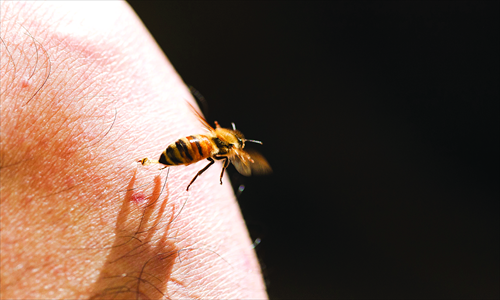
A bee thrusts its stinger into a patient. Bees are used to treat diseases like arthritis.Photo:IC
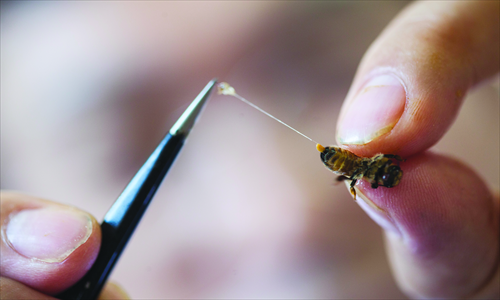
A doctor removes a bee stinger before using it on a patient.Photo: IC
When Chi Cheng was stung by a bee last year, he was surprised to experience relief from his spinal arthritis, rather than the usual pain and swelling. Chi, a 40-year-old traditional Chinese medicine doctor, had battled rickets for around a decade before his bee sting.
Now a convert of apitherapy, the medical use of bee products including venom, Chi doesn't hesitate to unleash his bees on patients suffering a wide range of ailments.
"I am a doctor but also a patient," he said, walking to a room near his clinic where beehives are stored. Moments after placing a small box near the hive's entry, it buzzes with dozens of bees.
Chi carefully carries the box of bees into his clinic in Changchun, Jilin Province. Picking up a bee with tweezers, he plucks its stinger and thrusts it into a knee of his grimacing patient. But Chi doesn't stop there. Over the next few minutes, he plucks dozens more stingers and methodically inserts them around both knees of his patient.
However, not everyone is brave enough for bee sting therapy. Some people fear bees, while others risk suffering potentially fatal allergic reactions.
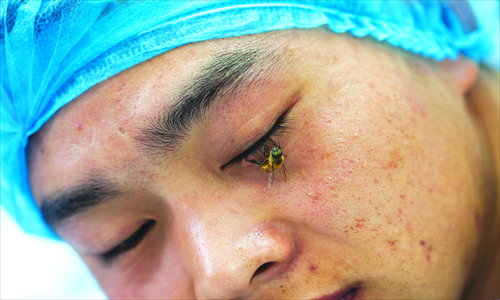
A patient receives bee sting therapy.Photo: IC
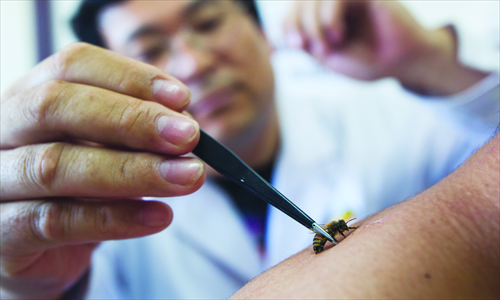
In 2010, Brazilian scientists found bee venom increases the body's levels of anti-inflammatory hormones called glucocorticoids.
Studies of bee sting therapy officially started nationwide in China in 1936, although the form of treatment was only formally accepted by State Administration of Traditional Chinese Medicine in February 2012. Now, bee sting therapy is mainly used for people suffering joint inflammation including arthritis, spondylosis and even multiple sclerosis.
Not all bee species are suitable for bee sting therapy. Italian bees, a subspecies of the European honey bee, are raised in captivity over several years and tested to ensure they don't cause any harmful side effects to patients before they are used by traditional Chinese medicine doctors.
Luo An, a traditional Chinese medicine doctor and bee sting therapy advocate, compared its effectiveness to acupuncture in an interview with The Nanjing Daily last October.
Wang Limei, one of Luo's patients, said the mantra of "no pain, no gain" is particularly apt for bee sting therapy.
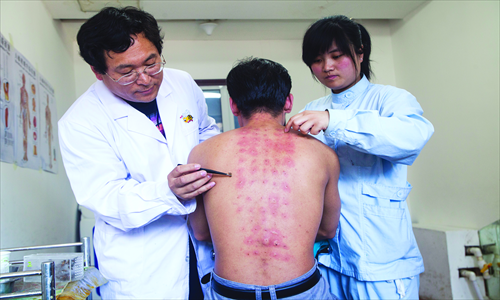
Doctors use tweezers to remove bee stingers from a patient's back. Photo:IC
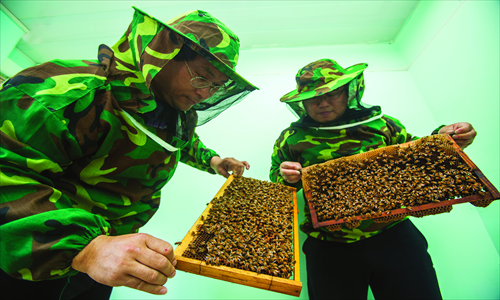
Doctors examine bees kept in beehives.Photo: IC
Despite bee sting therapy's long association with traditional Chinese medicine, Luo said the high levels of precision required by practitioners and courage by patients mean it remains a fringe treatment.
"Using stingers is not as easy as it looks. The correct acupuncture points must be located and the right number of stingers used varies, depending on the disease," said Luo, noting that using one too many or too few stingers can mean the difference between a cure and further complications.